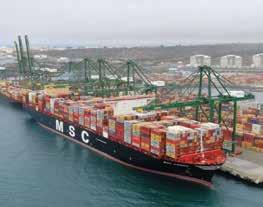
3 minute read
Shipping & Freight
Profits continue to flow in for Deep-Sea Carriers
The unprecedented “explosion” in profitability of the deep-sea shipping sector continues unabated. In the case of hamburg-based container shipping line, hapag Lloyd, Group CFO Mark Frese, commenting on the first quarter earnings, said; “Group profit of $1.45 billion was already significantly above the full-year 2020 figure of $1.06 billion”. The company’s first quarter revenue improved by about 33% to $4.9 billion, largely due to a higher container freight rate, which was on average up by some 38% to $1,509 per TEU (twenty-foot equivalent unit) compared to $1,094 in Q1. 2020.
Looking ahead, Group CEO Habben Jansen said that “the second quarter will again be very strong and not so dissimilar to what we have for the first quarter. After that we expect a gradual normalisation of the results in the second half of the year.” Freight rates may also
Naples based Grimaldi Lines has introduced its first pure Ro-Ro ferry service linking an Irish port to Continental Europe. The vessel Eurocargo Bari now sails twice weekly from Ringaskiddy, Cork to Antwerp, offering a weekly capacity in each direction of 250 unaccompanied trailers.
The Grimaldi Group also operates services through Dublin and Ringaskiddy using Con-Ro vessels and giving links to African, South American and Northern European ports. Much Irish cargo destined for North America is shipped through the Company’s ACL service and the new service from Ringaskiddy links with the Company’s Finnlines services along the Atlantic Arc.
Eurocargo Bari now operates a twice weekly Ringaskiddy/Antwerp service
CLdN continues to add capacity to its Dublin/Zeebrugge and Dublin/ Rotterdam routes and has chartered two additional vessels to further build capacity. It is operating a twice weekly Dublin/Santander/Liverpool/Dublin loop and intends to re-introduce the direct Dublin/Leixoes link later in 2021 as extra newbuilds are added to the company’s fleet.
DFDS continues to report strong traffic growth on its Rosslare/Dunkirk service and is said to be considering further increases in frequency to the current eight round trips weekly schedule. The Line is also introducing significantly enhanced capacity on its Dover/Calais route as well as a new Sheerness/Calais service.
Stena Line reports strongly increased first quarter carryings on its Birkenhead/ Belfast and Heysham/Belfast services, due mainly to the displacement of Northern Ireland traffic from the Central Corridor routes with their very rigorous Border Control Systems. The Line also intends to return the Stena Estrid and the Stena Horizon to its normal routes as freight traffic re-builds on Central Corridor routes, though may make the switch again should currently COVID-19 constrained French passenger traffic return later in the summer.
Irish Ferries has yet to announce full details of its planned Dover/Calais service. The Company expects to charter additional tonnage to supplement the Isle of Inishmore on the route and provide the high service frequency required for such a route. The launch comes at a time when several hauliers are returning to the Landbridge route for certain cargoes.
soften provided the COVID-19 effect that has driven goods consumption eases back.
The major immediate difficulty for the sector is the lack of available container capacity in which to load cargo. Container turnaround times have increased by 20% over the last year, despite the chartering of extra vessels to increase service frequencies. Most lines have also placed significant orders for new container equipment, in the case of Hapag Lloyd their new order was for 150,000 TEU. New ships are also on order for several lines.
Ferry capacity continues to build
MSC introduces electronic Bills of Lading
The World’s second biggest Container shipping line, MSC, is introducing the electronic bill of lading (eBL) facility for its customers around the world using a solution on an independent blockchain platform WAVE BL. The eBL enables shippers and other key supply chain stakeholders to receive and transmit the bill of lading document electronically. Its introduction is seen as a critical step in the overall digitalisation of the industry. It is also seen as the key to the reduction of administration costs in Supply Chains.











